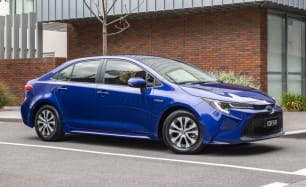The Corolla Ascent Sport Hybrid is a comfortable, stress-free driving experience. Toyota’s series parallel hybrid set-up means the wheels can be driven by the internal-combustion engine, electric motors, or both. And the transition happens seamlessly.
Start-up is silent with the motor(s) doing the driving at low speed, the petrol engine kicking in as the power requirement rises.
As the engine operates it’s also charging the battery and under braking the front wheels turning causes the motor and generator to send power to the main battery pack, as well.
Toyota doesn’t quote acceleration figures for the Corolla but you can expect 0-100km/h in around 12 seconds, which is hardly neck-snapping, however this hybrid combination provides enough torque for nimble acceleration in the city and suburbs as well as easy freeway cruising.
Then there’s the Continuously Variable Transmission. I’m no CVT fan, largely because of the disconnect between road speed and engine speed it creates. The transmission is always trying to keep the engine in its efficiency sweet spot and the most noticeable byproduct is an incongruous droning sound.
Developed by transmission specialist (and Toyota subsidiary) Aisin, the Corolla’s unit is ‘tighter’ than some but the sluggish ‘slipping clutch’ effect is still there from time to time.
Underpinned by Toyota’s TNGA platform, precise handling and excellent ride comfort are dynamic hallmarks of this 12th-generation Corolla. And the Ascent Sport Hybrid Sedan is no exception.
Suspension is by struts at the front and multi-links at the rear, and compliance is super impressive, especially for a car of this size.
The electrically-assisted steering is responsive and road feel is good, the car remaining planted and predictable, with only modest body roll if the red mist descends and you decide to ‘push on’ through your favourite set of corners.
This kind of response is especially noteworthy given the car’s low-rolling resistance Bridgestone Ecopia rubber (205/55) is primarily designed for efficiency rather than race-circuit grippiness.
Braking is by 255mm ventilated discs at the front (slightly smaller than the 2.0L non-hybrid’s) and 265mm solid rotors at the rear. They’re progressive with good pedal feel. Not always the case when regenerative braking is part of the picture.
In terms of general comfort and ergonomic efficiency, the seats remain comfortable, even over road-trip-style stints, while the mix of physical and digital controls is sensible and works well.
































































